Field Meeting Reports 2021
Holmethorpe Nature Reserve, Merstham, 12th December 2021
Superbly led by local birders Ian Kehl and Gordon Kay (our thanks to them both), and blessed with dry and an unseasonally warm weather, 13 members joined a very enjoyable walk around the varied habitats of Holmethorpe Nature Reserve. The Reserve incorporates a combination of Mercers Lake, Spynes Mere, Mercers and Chilmead Farm, The Moors and Watercolours 1&2 lagoons – hence why we managed to see 64 species, which for a Surrey location is a very good total.
Having met at Mercers Country Park and scanned Mercers Lake seeing Tufted Duck, Great Crested Grebes and Black-headed and Herring Gulls, we were treated to both a Red Kite and a Sparrowhawk high beyond the car park, the latter being harassed by a Carrion Crow. Within a minute of leaving to head over to Spynes Mere, Gordon had found a very well-camouflaged Little Owl in a mature oak adjacent to Mercers Farm. Everyone managed to get a view of this fantastic and elusive bird with many seeing it turn to look straight at us – a great start to the day!
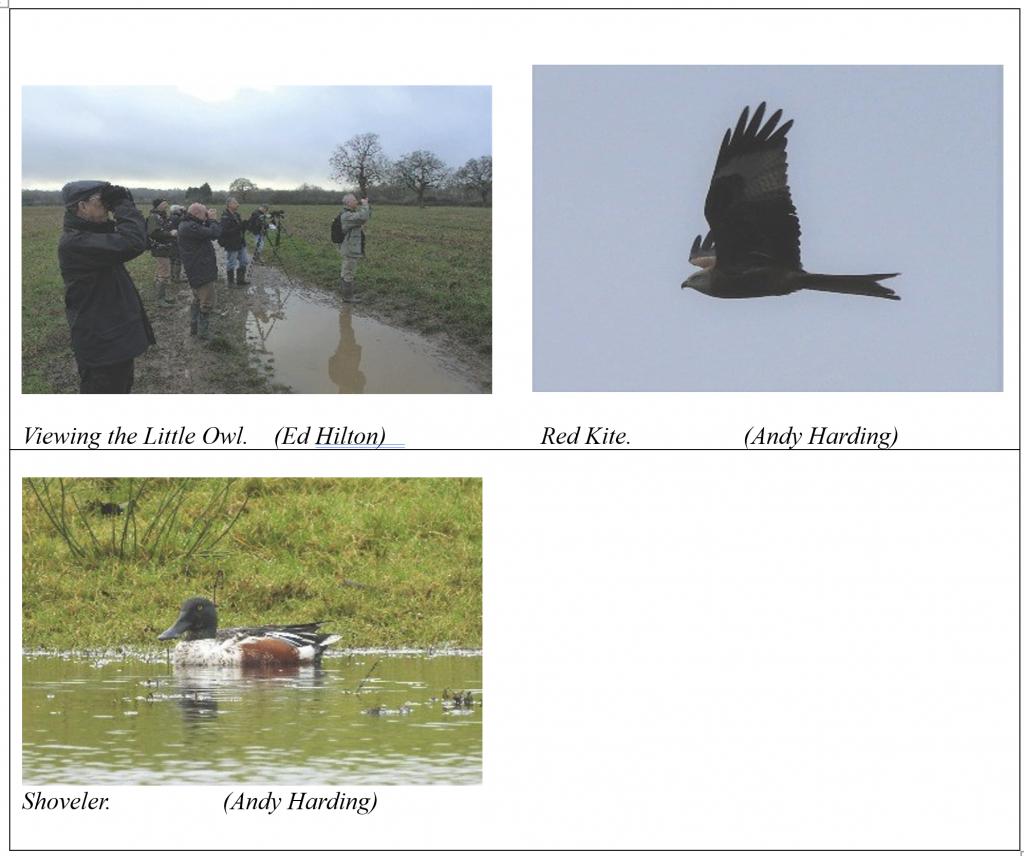
Past Mercers Farm, with an overhead Grey Wagtail calling and 5 Meadow Pipits on the cricket pitch, we all had superb views of a juvenile Red Kite quartering the stubble fields of Chilmead Farm and then posing on a bare branch -with shared scopes, everyone got some good views. A second Sparrowhawk was also seen hunting along the hedgerow. Plenty of Redwings and corvids about as we made our way round The Moors. This is a very productive area, particularly for passerines in the trees, hedgerows and embankment, with Goldcrest and Treecreeper heard then seen along with a pair of Great Spotted Woodpeckers and Great, Blue, Coal and Long-tailed Tits all seen. We were all captivated by a mixed flock of finches feeding in the alders with circa 10 Siskins and similar numbers of Lesser Redpolls, with up to 5 Chiffchaffs and some Goldfinches.
At the Railway Pools, Gordon picked out a very well-camouflaged Common Snipe and in amongst the pools within the willows were some good views of Teal. At Watercolour 1&2 there were good numbers of Teal, Shoveler, Wigeon and Great Crested Grebes.
A really enjoyable morning’s walk with a superb number of species seen.
| Canada Goose | Common Moorhen | Eurasian Green Woodpecker | Mistle Thrush |
| Mute Swan | Eurasian Coot | Common Kestrel | Song Thrush |
| Northern Shoveler | Northern Lapwing | Ring-necked Parakeet | Redwing |
| Gadwall | Common Snipe | Eurasian Jay | Eurasian Blackbird |
| Eurasian Wigeon | Black-headed Gull | Common Magpie | Fieldfare |
| Mallard | Common Gull | Eurasian Jackdaw | European Robin |
| Eurasian Teal | Herring Gull | Carrion Crow | Dunnock |
| Common Pochard | Lesser Black-backed Gull | Coal Tit | House Sparrow |
| Tufted Duck | Great Black-backed Gull | Eurasian Blue Tit | Grey Wagtail |
| Little Grebe | Great Cormorant | Great Tit | Pied Wagtail |
| Great Crested Grebe | Grey Heron | Long-tailed Tit | Meadow Pipit |
| Feral Pigeon | Eurasian Sparrowhawk | Chiffchaff | Commom Chaffinch |
| Stock Dove | Red Kite | Goldcrest | Eurasian Bullfinch |
| Common Woodpigeon | Common Buzzard | Eurasian Treecreeper | Lesser Redpoll |
| Collared Dove | Little Owl | Eurasian Wren | European Goldfinch |
| Water Rail | Great Spotted Woodpecker | Common Starling | Eurasian Siskin |
Papercourt Meadows, 20th November 2021
Fourteen of us gathered on this very overcast day at the Tannery Lane car park for the SBC visit to Papercourt Meadows. A singing Song Thrush welcomed us. We started by walking the towpath upstream of the Tannery Bridge, hoping to find the Siskins I had seen earlier in the week but they had moved elsewhere. On the field by the High Bridge Canada Geese, Starlings and Stock Doves were seen and a Buzzard posed nicely on a fallen tree. Mute Swans, Moorhen and Mallards were on the canal.
Back to Tannery Lane and then we took the path alongside the stubble fields towards the Papercourt Marshes Reserve. A good number of Greylag Geese were on the pasture opposite the path and a small flock of Linnets was disturbed from trees. By the reserve a Grey Wagtail flew over.
Papercourt Sailing Lake was next stop. The last of the boats were being taken from the water but several Pochard, Tufted Duck and Mallard were still amongst the numerous Coots. Great-crested Grebes and Black-headed Gulls also present and a Chiffchaff was seen and heard by some of the group.
We crossed the road and walked down past the smallholding where a Green Woodpecker was found showing nicely on a fence post. At the farm buildings several groups of Starlings were heading in to their nearby roost but no murmuration, just straight down into the reeds. A pair of Egyptian Geese were on the farm and a flock of Jackdaws went up with a loud shout heading to roost.
We crossed the Cut and onto the Meadows, hoping to see Barn Owls. Standing by the gate a repeated call confused us for a minute but then turned into classic Water Rail, not that far in front of us but deep in the sedges. We started to follow the path alongside the Cut back to the car park when a Barn Owl was briefly spotted flying on the far side of the river. Another, or maybe the same bird, was seen by the river opposite the Tannery Lane bridge. Both sightings were very brief and unfortunately not everyone managed to see one. We finished the afternoon with 32 species.
Thanks to everyone who came to share an afternoon on my local patch.
Carey Lodge (Trip Leader)
Farlington Marsh, Saturday 23 October 2021
Our group for the field trip to the Hampshire Wildlife Trust reserve at Farlington Marsh numbered 11 and most of us set off south down the A3 in various degrees of hope and expectation. The forecast was for light winds and a fairly cool 12 degrees , however at times it felt a good bit colder particularly while we stayed relatively still looking at the many birds on show.
The reserve offers quite a few different habitats from salt marsh, brackish lagoons, grazing marsh, and, when the tide comes in, a great expanse of water that is Langstone Harbour. Even from the car park we quickly picked up Common and Black-headed Gulls, Greenshank, Cormorant, Mute Swan, Black-tailed Godwit, Redshank and Oystercatcher. The walk around the perimeter of the reserve yielded an excellent total of 64 species (Water Rail, Chiffchaff and Cetti’s Warbler were heard only) including many winter visitors and even some summer ones eg 3 Swallows on their way to Africa.
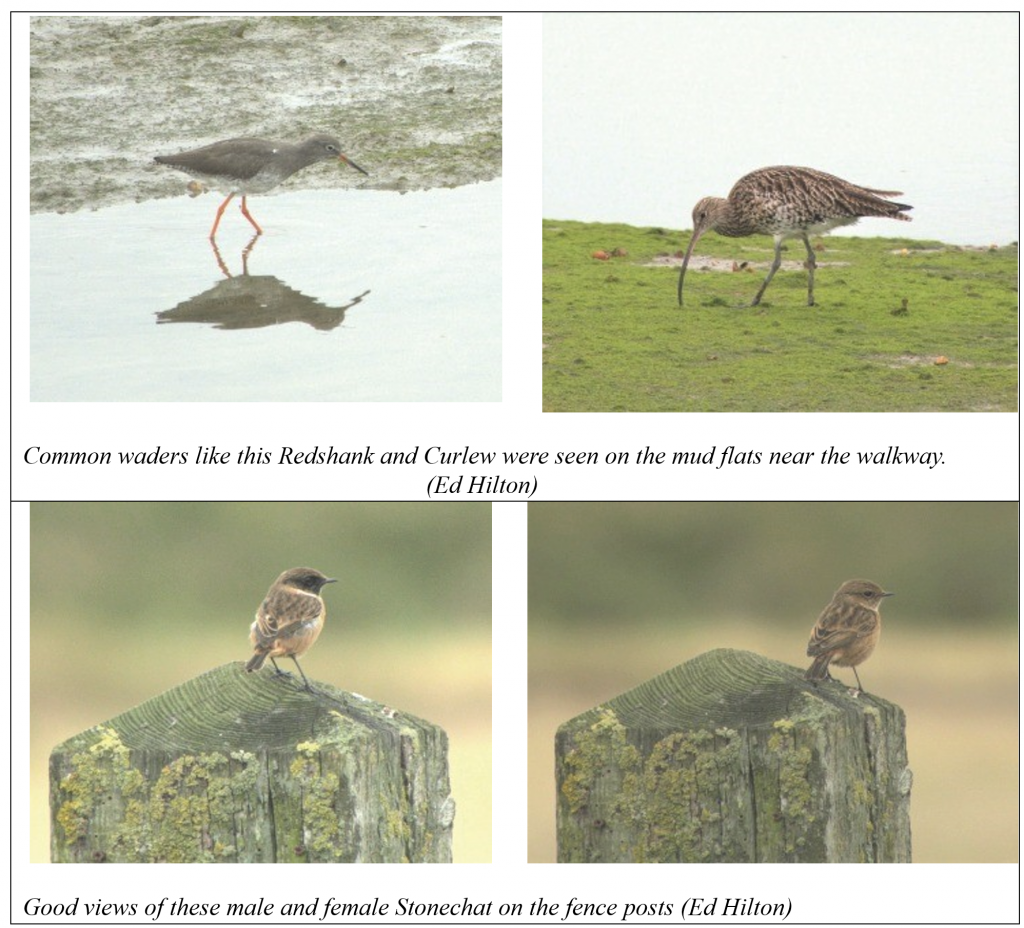
On the walk we also saw 2 Common Seals and a few Rabbits, the skeleton of one encouraging Charlie to collect a jaw bone! For many it was a raptor fest , seeing Marsh Harrier, Buzzard, Kestrel, with some great views of Peregrine Falcon.
The sight and sound of the many hundred of Brent Geese was impressive and we also saw 2 Barnacle Geese , one of which is half of the odd-couple as it is paired to a large white ‘farmyard’ goose – a relationship which has been ongoing for at least 5 years!
With so much on offer we over-ran the planned time a little , but hopefully with appetites whetted we will come back again next year.
Day Bird List, Number of Taxa: 64 (Courtesy of Andy Harding)
| X Brent Goose (Dark-bellied) | X Grey Plover | 2 Common Kestrel |
| 2 Barnacle Goose | X Northern Lapwing | 2 Peregrine Falcon |
| 1 Canada Goose | 20 Common Ringed Plover | 1 Eurasian Jay |
| 3 Mute Swan | X Eurasian Curlew | 3 Common Magpie |
| 9 Common Shelduck | X Black-tailed Godwit | X Carrion Crow |
| X Northern Shoveler | 2 Ruddy Turnstone | 2 Common Raven |
| X Gadwall | X Dunlin | 3 Eurasian Skylark |
| X Eurasian Wigeon | 1 Common Snipe | 1 Bearded Tit |
| X Mallard | 2 Common Greenshank | 3 Barn Swallow |
| 8 Northern Pintail | X Common Redshank | 1 Common Chiffchaff h |
| X Eurasian Teal | X Black-headed Gull | 1 Cetti’s Warbler h |
| 5 Red-breasted Merganser | 6 Common Gull | 2 Eurasian Wren |
| 2 Common Pheasant | 1 Herring Gull | X Common Starling |
| 2 Little Grebe | 1 Great Black-backed Gull | 3 Song Thrush |
| X Great Crested Grebe | 2 Sandwich Tern | X Eurasian Blackbird |
| 1 Stock Dove | 2 Great Cormorant | X European Robin |
| X Common Woodpigeon | 3 Grey Heron | 5 European Stonechat |
| 1 Water Rail h | X Little Egret | 1 Pied Wagtail/White Wagtail |
| X Common Moorhen | 1 Western Marsh Harrier | 3 Meadow Pipit |
| X Eurasian Coot | 2 Common Buzzard | 10 Common Linnet |
| X Eurasian Oystercatcher | 1 Common Kingfisher | X European Goldfinch |
| (Heard only : h) | 2 Common Reed Bunting |
Dudley Cox
Tice’s Meadow, 19 September 2021
I had the pleasure of leading a guided tour of Tice’s Meadow Nature Reserve for sixteen members of the Surrey Bird Club. Despite the rain, which unfortunately arrived at the start of the walk, we spent two and half hours walking around site, spotting sixty species of bird. The walk started off with discussion of the good news that had recently broken in the local press – Tice’s Meadow’s future was looking more assured, as a consortium of six local councils are now the preferred bidder for the site. Whilst nothing has been signed, the Tice’s Meadow Bird Group look forward to working closely with the new landowner to continue the years of good work already undertaken on site.
Highlights included a Greenshank, two Ringed Plover, eight Snipe and a Kingfisher. Winter duck numbers were building, with four Wigeon and sixteen Pochard loafing on the newly exposed islands.

Shelter & Hide at Tice’s Meadow Mark Elsoffer
It was great to be able to use our new hide, only recently emerged from the depths, which afforded us close views of the Great Crested Grebes feeding their young, whilst also keeping us all dry.
Mark Elsoffer
Oare Marshes Nature Reserve, North Kent, 22nd August 2021
An extremely enjoyable morning which, despite the threat of rain, remained dry. Recent reports of Glossy Ibis, Bonaparte’s Gull, Whinchat, Garganey, Yellow Wagtail and Turtle Dove, certainly whetted our appetite for a good morning’s birding.
Meeting by the slipway, opposite the Isle of Sheppey, with the tide out, there was a surprisingly good number of gulls and waders to start the day off. Of particular note was a close-in Whimbrel, which showed off it’s striped head and could compare build and size to a nearby Curlew. In addition, Redshank, Ringed Plover, Dunlin and a superb summer plumaged male Grey Plover were all feeding on the exposed mudflats. Also a good selection of gulls were identified including 2 Common Gulls and single Great Black-backed and Herring Gull, with a good number of Mediterranean Gulls amongst the Black-headed.
Heading towards East Flood, we had Yellow Wagtails calling low overhead and Starlings starting to form small flocks which were almost looking to murmurate! At East Flood we were surprised at the huge numbers of Black-tailed Godwits in various forms of plumage, and in amongst them was a good number of Redshank and a beautiful Golden Plover, just coming out of summer plumage. Wildfowl were all in their usual tricky eclipse plumage but we were able to distinguish Gadwall, Mallard, Teal and Shoveler.
We headed passed the cottages to the fields and scrub where the Turtle Doves normally are found, but no joy, not helped by a group of paintballers! Back onto the East Flood for the circuit walk and immediately had 3 Avocets fly in from the Swale to join the Godwits. We were also able to pick out the two eclipse Garganey feeding in open water, which allowed us all to make out their head markings albeit in a dumbed-down form. A leisurely stroll round the perimeter path back to the car park, gave us the excellent sighting of 11 Bar-tailed Godwits overhead, more Black-Tailed Godwits coming off the Swale and some challenging bird call identification for Reed Buntings. As we left the Reserve, Ed and I had a Marsh Harrier quartering the cornfields.
An excellent morning for the 10 of us, helped by the excellent company, the sharp eyes of Scott Lawrence and good sightings of Garganey, Yellow Wagtail, Bar-Tailed Godwit and Avocet – and the rain stayed away – culminating in a total of 55 species seen.
| Mute Swan | Pied Avocet | Mediterranean Gull | Barn Swallow |
| Garganey | Grey Plover | Common Gull | Common Whitethroat |
| Northern Shoveler | European Golden Plover | Herring Gull | Wren |
| Gadwall | Northern Lapwing | Great Black-backed Gull | Starling |
| Mallard | Common Ringed Plover | Common Tern | Blackbird |
| Teal | Whimbrel | Sandwich Tern | Robin |
| Tufted Duck | Curlew | Great Cormorant | Dunnock |
| Little Grebe | Bar-tailed Godwit | Grey Heron | House Sparrow |
| Woodpigeon | Black-tailed Godwit | Little Egret | Yellow Wagtail |
| Stock Dove | Ruddy Turnstone | Western Marsh Harrier | Pied Wagtail |
| Collared Dove | Dunlin | Common Buzzard | Linnet |
| Common Swift | Common Snipe | Kestrel | Goldfinch |
| Moorhen | Common Redshank | Magpie | Reed Bunting |
| Coot | Black-headed Gull | Great Tit |
Andy Harding
London Wetland Centre, Barnes, Sunday 25th July 2021
The forecast for this field trip was not good with heavy showers forecast but, despite this, everyone who had booked to come on this field trip turned up plus one other member. Please do book in advance if you want to come on a field trip, even if there are no Covid-19 restrictions in place. It helps the club manage the field trip and work out who, if required, can act as an assistant leader.
I had eight members joining me and, as LWC does not open until 9.30 and everyone had attended promptly, whilst we were waiting to go in, we had a lovely view of a Mute Swan and an extremely small Moorhen chick. A Cetti’s Warbler called out loudly too. After going in through the entrance (and booking in our vehicles to avoid a parking ticket), we were kindly given a short history of the London Wetland Centre by one of the volunteers. Whilst we were listening we had both Swifts and Ring-Necked Parakeets flying over us. One species was quite a lot louder than the other!
We then went into the Observatory where we saw not only Swifts feeding over the water but also lots of Sand Martins. In the water were the summer ducks you would expect to see namely Mallard and Tufted Duck and we could also see Lapwing, Cormorants, Grey Heron and Canada Geese.
We then made our way to the Wildside Hide where we hoped we might see a Whinchat as one had been reported a couple of days earlier. On the way a number of Six Spot Burnet Moths were spotted. At the hide no luck with spotting a Whinchat, a young Robin was behaving in a similar way to try to confuse us, but Claire impressed us all by spotting a Green Sandpiper on the weir. We also managed to see Gadwall, Great Crested Grebe and a Common Tern from that hide. We checked out the nearby hospital for nesting Peregrine but nothing visible there and so we made our way back, via another route, to the entrance.
Shortly after leaving the hide we had great views of a terrapin and an Emperor Dragonfly laying eggs. We also got very brief views of a Reed Warbler and heard some more Cetti’s Warbler. On the way back there was clearly a raptor somewhere, due to the alarm calls we heard from the passerines in the trees, but we failed to locate the raptor. However, whilst checking out the trees we saw LongTailed Tit, Blue Tit and Blackcap and we heard both Goldfinch and Greenfinch.
After passing the entrance we made our way to the hide with the view of the Sand Martin bank. On the way we all had good views of a Jersey Tiger Moth and most of the group took a photo. On getting to the hide, there were quite good views of the Sand Martins but there were no waders in front of the hide nor a Hobby nor Kestrel trying to catch the Martins. The volunteer from LWC had told us that this is an issue.
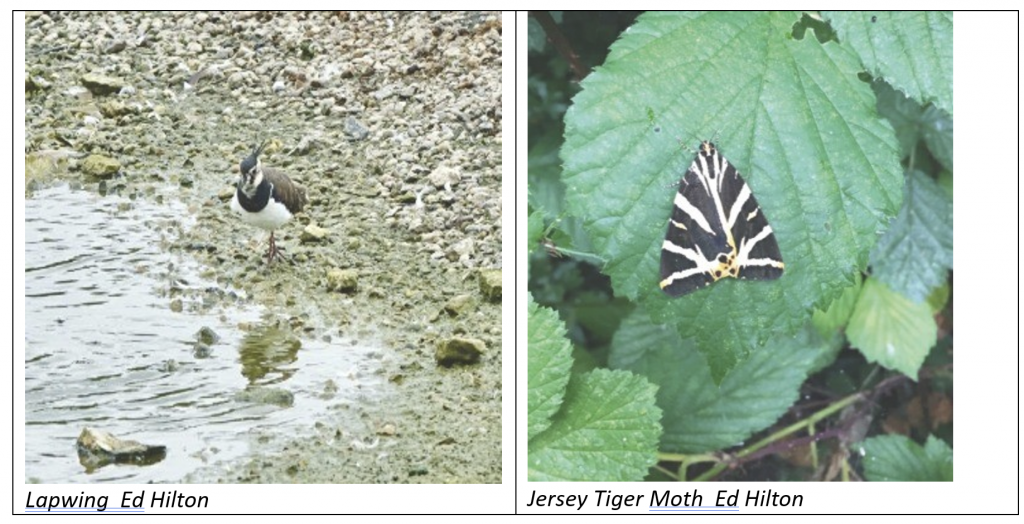
We then made our way to the Peacock hide which has a great view over the reserve. Some birders in the hide suggested there was an elusive Stonechat around but we failed to spot it. However we did manage to add Lesser BlackBacked Gull, Egyptian Goose and Starling to the list. It was also good to see both Woodpigeon and Stock Dove next to each other in order to compare size and markings. Despite searching hard we failed to see either House Martin or Swallow which was surprising as there were clearly insects around as Swifts and Sand Martins were feeding all the time.
We managed to leave before the heavy showers which started as I was driving out of the car park. It was very interesting to visit the LWC during the summer as, in the past, we have only had field trips there during the winter. The flowers were very beautiful but it did make it more difficult to look out over some of the lakes. All in all, a good morning with a total of 32 bird species.
Penny Williams
Beddington Farmlands, Sunday 23rd May 2021
Despite being well into Spring and warmer weather should have been well and truly with us, our trip to Beddington Farmlands was hampered, though not spoiled, by a few downpours, – but they did give us more time to stay under the hide shelters at various points of the reserve.
We had a total of 10 birders on the trip which certainly made for a very enjoyable morning and with so many pairs of eyes and ears we were able to identify either by sight or calls, 54 species, which was a very good return given the weather conditions.
Having met at Hackbridge station car park, we had got wind that a Caspian Gull had been seen on the wet grassland area; so we headed in that direction taking in the scrub over the railway bridge, the Northern Lake and then onto the Mound overlooking the Wet Grasslands.
On the way, most of the common birds expected were seen, with good number of hirundines over the lake, in particular House Martins, and a good number of Swifts. As is a characteristic of this reserve there were large number of gulls, which made for some challenging IDs, with Black-headed, Herring and Lesser Black-backed all being identified in a variety of plumages and ages, but sadly no Caspian. We also had great examples of identifying the songs of Common Whitethroat and Blackcap, both of which were heard and identified before being seen.
At the Mound, we were very fortunate to see both Common Ringed and Little Ringed Plovers right in front of us – so that we could compare size, and key identification pointers – in particular we could easily see the yellow orbital eye ring of the smaller plover. We also had great views of the beautiful Grey Wagtail in the margins and Shelduck in the rear corner.
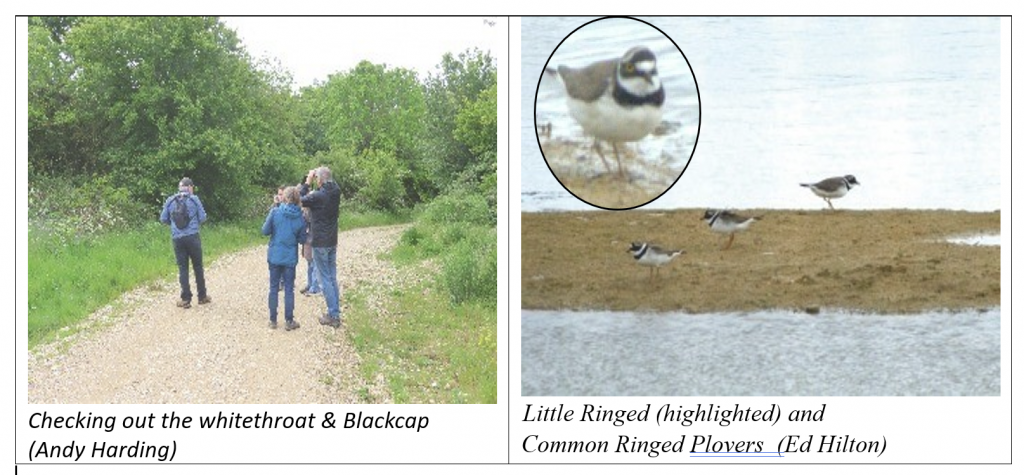
Someone shouted “Raptor” and we all looked up to get excellent views of the local Peregrine flyover the hide as we sheltered from the rain again.
Making our way down to the Southern Lake, we all noted the good numbers of Greenfinches on the reserve, which given their national numbers it was good to see. The Southern Lake offered a different habitat with close-in reeds and open water where we were able to identify Common Pochard, Tufted Duck, Gadwall and Little Grebe. A number of LBJs were identified in the reeds immediately in front of the hide, which with a combination of song, keen-eyed spotting and some good use of telescopes we found Reed Bunting, Reed and Cetti’s Warbler.
A really enjoyable morning’s birding with excellent company and some good species seen within this classic urban reserve – one to visit in the early autumn for migrant waders and winter for a combination of gulls, waterbirds and winter visitors.
| Canada Goose | Lesser Black-backed Gull | Chiffchaff |
| Mute Swan | Cormorant | Whitethroat |
| Shelduck | Grey Heron | Cetti’s warbler |
| Gadwall | Sparrowhawk | House Martin |
| Mallard | Buzzard | Sand Martin |
| Common Pochard | Peregrine | Barn Swallow |
| Tufted Duck | Kestrel | Wren |
| Little Grebe | Great spotted Woodpecker | Starling |
| Woodpigeon | Ring-necked Parakeet | Blackbird |
| Stock Dove | Magpie | Robin |
| Feral Pigeon | Jackdaw | Dunnock |
| Swift | Carrion Crow | House Sparrow |
| Moorhen | Blue Tit | Grey Wagtail |
| Coot | Great Tit | Pied Wagtail |
| Common Ringed Plover | Coal Tit | Chaffinch |
| Little Ringed Plover | Long-tailed Tit | Greenfinch |
| Black-headed Gull | Reed Warbler | Goldfinch |
| Herring Gull | Blackcap | Reed Bunting |
Andy Harding
Holmethorpe Nature Reserve, 18 April 2021
We were lucky that it was a bright sunny day for our first field trip of 2021 after the earlier lock down. 18 of us gathered near the Aqua Sports centre of Mercers’ lake and formed 3 groups led by experienced birders: Ian Kehl, Gordon Hay and Andy Harding. While we waited for everyone to arrive, Gordon spotted a Lapwing high overhead. Setting off towards Spynes Mere, we crossed Mercers Farm hearing Blackcap in the hedges to our left, and seeing a pair of Egyptian Geese ahead on the grass; a Little Owl was glimpsed in an oak tree. As we approached Spynes mere a pair of Sparrowhawks gave good overhead views on several occasions, at one point landing on a nearby tree. Looking across the mere,numbers of Sand Martins (up to 30) were seen flying low over the water, no doubt attracted by the sand banks at the far end. Some of the groups did a circuit of the mere at this point spotting Reed Bunting, Teal and Greenfinch, and hearing Cetti’s Warbler.
On our way back several Swallows were seen gliding and swooping overhead, confirming the season of Spring. There were good views of the Blackcap that we had heard earlier and a Chiffchaff singing high on a tree by the path; several Greylag Geese were also seen feeding in the field to our left and on the mere itself.
At Mercer’s Farm, behind Canal Cottage, we took a short detour to catch some much appreciated views of 3 Yellowhammer flitting between trees, ground and bushes. Walking back across Nutfield Marsh and along Chilmead lane, a Red Kite was seen overhead, and there were good views of 2 Goldcrest feeding in low hanging branches by the path.
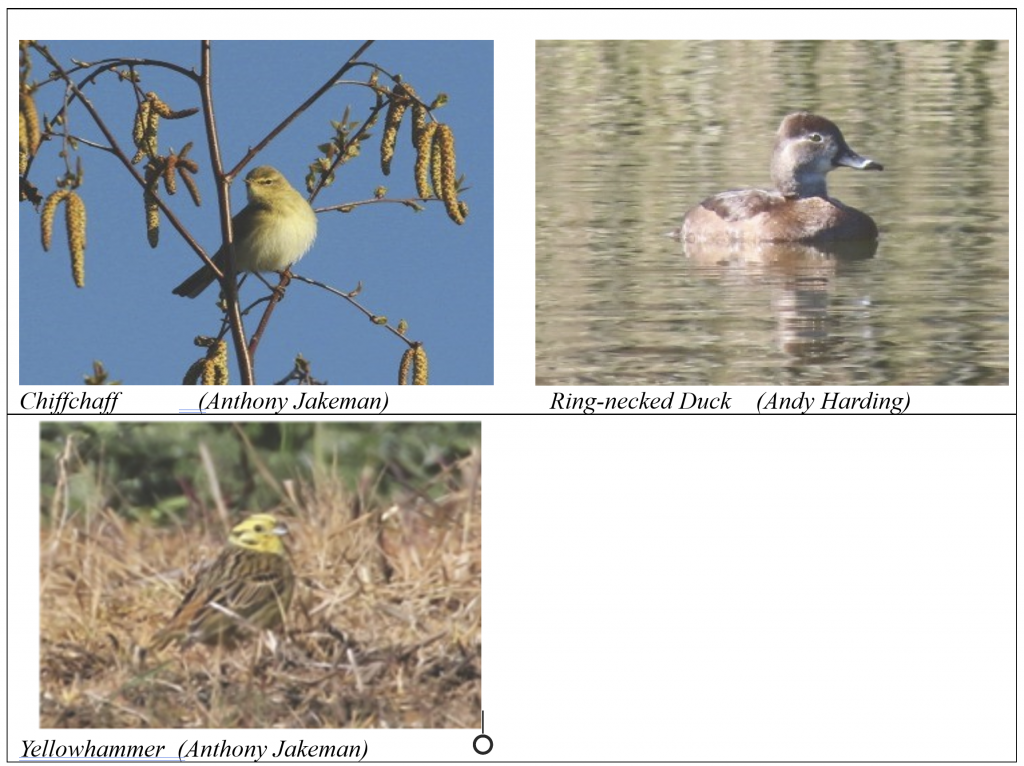
We walked along the Moors seeing Heron, Goldfinch, Moorhen and Coot and reached the Railway Ponds. Here the female Ring-necked Duck, that has made this its home, showed well, ducking and diving and allowing photographs to be taken. Other water birds seen in this area included Shoveler, Tufted Duck, Great Crested and Little Grebes, all close enough to get good views.
On our way back, climbing over Watercolours mound we heard Whitethroat and Willow Warbler; the Whitethroat was difficult to see but was glimpsed in the brambles, but the Willow Warbler was seen easily high in a silver birch tree. Walking past Watercolours lake, Reed Warbler could be heard in the reed bed near the path.
We approached the road, at the end of Watercolours, and were treated to a view of fox cubs playing under a hedge not far from the path. Close to this we passed a pool of water teaming with fish, which is apparently a popular spot for local Kingfishers, although none were seen today.
Our way back to the car park took us through woods along Mercer’s edge and a Nuthatch was heard but not seen. As we reached the car park, the sun was still shining and it had become quite warm; high in the sky, 5 buzzard, of various kinds, were seen circling in the thermals, an end to a very enjoyable morning of bird watching.
Throughout the trip a variety of commoner birds were seen and heard, including Goldfinch, Sparrow, Jay, Magpie, Linnet, Chaffinch, Starling, Great, Long-tailed, Coal and Blue Tits, Song Thrush, Robin, Blackbird, Dunnock, Wren, Pied and Grey Wagtail, Stock Dove, Herring Gull, Collared and Wood Pigeon, Canada Goose, Cormorant and Mallard. A total of 61 species was seen and/or heard.
Ed Hilton
